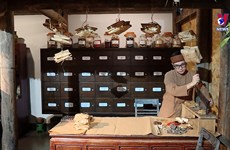Exhibition features heroic women in American War
Eighty-three-year old Nguyen Thi Lap could not hold back her tears as
she recalled the experiences of female revolutionaries from the
southern part of the country during the American War.
Eighty-three-year old Nguyen Thi Lap could not hold back her tears as
she recalled the experiences of female revolutionaries from the
southern part of the country during the American War.
From 1962, Lap had led the "Long-haired Army" in Mekong delta Can Tho city's Giai Xuan commune.
"I have been jailed and tortured by the enemy many times, but when I was released, I immediately joined the movement again and encouraged other women to join."
She also told Vietnam News that when she and her husband were away from home, participating in the resistance, her five-year-old daughter fell into a well and drowned.
"I went crazy and wanted to kill myself," she said, crying, "but then I realised that many other women were even more unfortunate than me. Many of them lost one, two or even three children because of the war."
Vietnam News spoke to Lap as she looked at photographs and other war memorabilia displayed at the exhibition Two Sisters – Two Frontlines now open at the Vietnamese Women's Museum in Hanoi.
The exhibition marks the 55th anniversary of the "Long-haired Army" (1960-2015) and the 50th anniversary of the "Three responsibilities" (1965-2015) movements.
At the exhibition's opening ceremony on March 6, Nguyen Thien Nhan, President of the Vietnam Fatherland Front Central Committee, said the resistance against the US reaffirmed the important role of Vietnamese women who were courageous, undaunted, loyal and capable.
They not only encouraged their husbands and sons to go into battle, they also joined the fight themselves, he said.
"I expect that the exhibition will draw a large number of visitors, especially men," he said.
"Through this exhibition, they can understand and respect more the Vietnamese women who lived during the war and those who are around them now."
The Vietnamese Women's Museum co-operated with the Southern Women's Museum and the Museum of Nam Dinh province to present the exhibition.
Duong Thi Hang, a museum officer, said the exhibition was dedicated to Vietnamese women who contributed to the nation's victory.
"We have re-constructed an A-shaped bomb shelter which was popular during the American War to give visitors a chance to get into the shelter and imagine the wartime," she said.
After the Geneva Agreement on restoring peace in Vietnam was signed in 1954, Vietnam was divided into two regions.
The North was liberated and entered a period of building socialism and joined the South in fighting US imperialism and reunifying the country.
Women from all the regions took part in many activities that aided the war effort and directly contributed to the nation's revolutionary cause.
Founded on March 8, 1961, the Women's Union Liberation of southern Vietnam became an effective banner that gathered women from all walks of life to join the resistance.
Women in southern Vietnam creatively carried out the "Long-haired Army" movement, combining combat with political struggle, military and agitprop among enemy troops.
Their northern brethren joined the "Three Responsibilities" movement launched in March 1965, which had them take active roles in industrial production, looking after the family and in defending the homeland.
The exhibition will run until March 31.-VNA
From 1962, Lap had led the "Long-haired Army" in Mekong delta Can Tho city's Giai Xuan commune.
"I have been jailed and tortured by the enemy many times, but when I was released, I immediately joined the movement again and encouraged other women to join."
She also told Vietnam News that when she and her husband were away from home, participating in the resistance, her five-year-old daughter fell into a well and drowned.
"I went crazy and wanted to kill myself," she said, crying, "but then I realised that many other women were even more unfortunate than me. Many of them lost one, two or even three children because of the war."
Vietnam News spoke to Lap as she looked at photographs and other war memorabilia displayed at the exhibition Two Sisters – Two Frontlines now open at the Vietnamese Women's Museum in Hanoi.
The exhibition marks the 55th anniversary of the "Long-haired Army" (1960-2015) and the 50th anniversary of the "Three responsibilities" (1965-2015) movements.
At the exhibition's opening ceremony on March 6, Nguyen Thien Nhan, President of the Vietnam Fatherland Front Central Committee, said the resistance against the US reaffirmed the important role of Vietnamese women who were courageous, undaunted, loyal and capable.
They not only encouraged their husbands and sons to go into battle, they also joined the fight themselves, he said.
"I expect that the exhibition will draw a large number of visitors, especially men," he said.
"Through this exhibition, they can understand and respect more the Vietnamese women who lived during the war and those who are around them now."
The Vietnamese Women's Museum co-operated with the Southern Women's Museum and the Museum of Nam Dinh province to present the exhibition.
Duong Thi Hang, a museum officer, said the exhibition was dedicated to Vietnamese women who contributed to the nation's victory.
"We have re-constructed an A-shaped bomb shelter which was popular during the American War to give visitors a chance to get into the shelter and imagine the wartime," she said.
After the Geneva Agreement on restoring peace in Vietnam was signed in 1954, Vietnam was divided into two regions.
The North was liberated and entered a period of building socialism and joined the South in fighting US imperialism and reunifying the country.
Women from all the regions took part in many activities that aided the war effort and directly contributed to the nation's revolutionary cause.
Founded on March 8, 1961, the Women's Union Liberation of southern Vietnam became an effective banner that gathered women from all walks of life to join the resistance.
Women in southern Vietnam creatively carried out the "Long-haired Army" movement, combining combat with political struggle, military and agitprop among enemy troops.
Their northern brethren joined the "Three Responsibilities" movement launched in March 1965, which had them take active roles in industrial production, looking after the family and in defending the homeland.
The exhibition will run until March 31.-VNA












